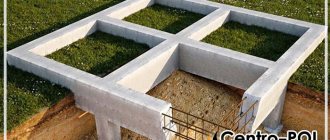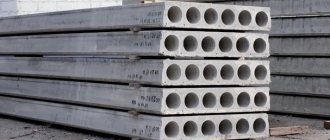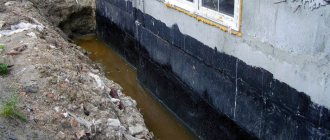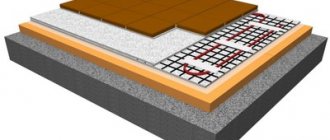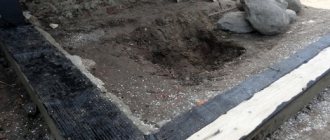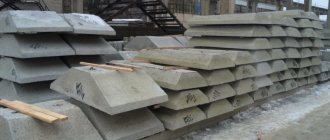Base structure
There are two variations of slab foundations - shallow, without recess. In the first case, the plant layer of soil is removed from the base, a sand cushion and crushed stone are poured, waterproofing is laid, and formwork is installed. The next step is to knit and lay a reinforcement cage, which is gradually poured with concrete, constantly using vibration equipment for better shrinkage.
In the second case, the first three points are completely skipped; work begins by covering the soil with insulating material. The rest of the steps are the same.
This can be a poured monolith, or two or more slabs, the joints of which are filled with a cement-sand mixture.
The most preferable option is a solid fill that does not form seams, allowing you to control the density of shrinkage. Reinforcement is carried out evenly over the entire area, without displacements or differences in the width/shape of the cells.
Rolled waterproofing under the foundation slab
Moisture-proof materials are produced on various bases:
- bitumen;
- polymer.
They are supplied in rolls and fixed in various ways:
- by fusing onto concrete using burner heating;
- by gluing using a special mastic.
The traditionally used material is roofing felt. It is a cardboard base impregnated with bitumen.
Rolled. A long-known method that is fully justified, although the durability of such waterproofing is not too great
The main advantages of the application are:
- cheap material;
- ease of fixation.
The list of disadvantages significantly exceeds the list of advantages. Weaknesses of the material:
- fragility at negative temperatures;
- insufficient strength;
- limited service life;
- tendency to cracking at bends;
- low elasticity of the hydrophobic layer.
Modern waterproofing materials are replacing outdated roofing felt:
- glass ruberoid;
- stekloizol;
- hydroisol;
- rubemast.
Installation is quite quick and simple; all you need is a burner to heat up the mastic.
Waterproofing the slab with roll waterproofing is done by laying a protective layer on a compacted gravel-sand backfill. In this case, an overlap of 15–20 cm should be ensured. Concrete can be poured onto the waterproofing material. After hardening, it is necessary to waterproof the top and end surfaces.
To do this you need:
- Clean them from dust.
- Cover with mastic.
- Cut the canvas.
- Glue the roll moisture protection.
To perform the work, you can use any type of rolled waterproofing materials.
Reasons for waterproofing a monolith
The monolith needs protection from moisture.
When pouring, the concrete solution should not be given too much density; small pores will remain through which water will actively penetrate into the slab.
Due to waterlogging, the foundation will begin to become covered with mold and will gradually collapse; constant contact with moisture will reduce the overall strength of the monolithic fill.
Waterproofing before concreting
The destruction of one section of the foundation is enough for the process of moisture penetration with subsequent destruction throughout the entire slab to be significantly accelerated. The result is a broken, unusable foundation, with a warped, cracked building.
When waterproofing from all sides of the fill, there is a complete cutoff of groundwater and no direct ingress of precipitation.
The advantages of insulation are the ability to maintain a constant temperature in the house, greatly prolonging the life of the building. The reinforcement distributes the load well, the building does not sag at different points.
The main task of moisture insulation is to seal the concrete base and maintain its integrity, which can be achieved using insulating materials or combining them.
Consequences of lack of insulation:
Why is a slab foundation waterproofed?
The monolithic mass contains small pores, which act like capillaries at high humidity.
Unprotected concrete gradually absorbs moisture, which causes negative consequences:
- the strength characteristics of the monolith decrease with constant waterlogging;
- water is concentrated in the pores, which increases in volume during crystallization;
- a damp base causes dampness in the room, which leads to the formation of mold.
In the absence of waterproofing, the foundation will gradually deteriorate. This will accordingly affect the stability of the building.
Whatever method of foundation installation you choose, it is important to remember that measures to cut off ground moisture from it are mandatory
Water protection solves a number of serious problems:
- seals concrete, maintaining its integrity. The concrete mass is weakened when moisture freezes;
- allows you to maintain a favorable indoor microclimate. Under normal humidity conditions, mold does not form;
- increases the service life of the base. The rise of moisture through the capillaries stops, which has a positive effect on durability;
- protects reinforcing bars from corrosion. Waterproofing the foundation preserves the strength properties of the reinforcement.
Types of waterproofing
To choose a waterproofing material, you will need to understand the basic parameters.
It is necessary to create a coating to create a single layer without gaps, cracks, or technological holes. It is necessary to provide additional water protection at points of maximum moisture accumulation.
Copes with the protective functions of the blind area, which is laid along the perimeter of the building, butted against the outer walls of the foundation. The structure partially blocks the influx of soil moisture and removes precipitation.
If groundwater is close to the soil surface and is in excess, drainage is an option for water disposal.
When choosing insulation, the general characteristics and basic properties are correlated with the dimensions and thickness of the casting of the monolithic slab.
The specific type of waterproofing is chosen based on the actual state of affairs; one material cannot always protect two identical foundations equally.
It is necessary to take into account climatic conditions, how much precipitation falls, altitude, amount of groundwater, drainage. The decision is influenced by the features of the fill and the size of the construction budget.
Roll material
Roll waterproofing saves the budget and effectively protects the foundation.
Structurally, the carpet is multi-layered and easy to install yourself.
There are several alternative options for roofing felt with a cardboard base:
- filizol;
- isolated;
- bicapol;
- elabit;
- isoplast;
- loves;
- glass master
The thickness rarely exceeds 2 mm, but can withstand pressure of 0.5-0.6 MPa. Materials - a mixture of fiberglass base, bitumen impregnation, additives. Durable, elastic coating withstands temperature changes.
Rolled moisture protection
The raw materials are used when pouring a concrete screed; you will need to overlap 2-3 layers, leaving a gap of 15-20 cm. The edges, laid on another sheet, are covered with bitumen mastic to create a sealed seam.
The floor covering should have a spacing of 20-30 cm from the edges of the slab being poured.
But there are conditions that must be strictly observed. Waterproofing can be applied to concrete whose moisture content does not exceed 4% and the surface is completely clean.
Options differ in application method. There are hot-type products; on the reverse side there is a bitumen layer, which must be heated with a gas burner in order to firmly adhere the waterproofing. Cold methods can be used.
It is recommended to use one type of insulation at a time, or not to replace the solid roll with bitumen if, for example, roofing felt is already laid underneath. You can combine, but you need to maintain the integrity of the coating on the sides.
Coating type
Coating waterproofing is applied over hardened concrete with a brush, roller, or spray. The result is a single coating without seams or joints, ensuring tightness.
An effective, simple material is produced in the form of hot or cold mastics, or emulsions. Types of mastic, application method, manufacturers are indicated on the packaging.
Coated insulation applied
Simple material serves its intended purpose well.
If it is decided to protect the foundation with a coating material, the bulk cushion for pouring must be thoroughly saturated with liquid bitumen.
However, the substance can only be used on a completely dry surface. Even small splashes compromise the seal of the insulation.
Bituminous mastic dries quickly, and you can begin installing formwork, reinforcing, and concreting the slab.
Penetrating nature
Penetrating impregnation is a liquid that penetrates deep into the porous structure to a small depth. The material crystallizes quickly and prevents moisture penetration.
Crushed stone, sand are laid, roofing felt is laid, followed by the construction of a solid base slab. When the foundation is completely dry, the side surfaces are treated with a crystallizing substance.
Working principle of penetrating insulation
The liquid that gets on the surface immediately reacts with the lime contained in the concrete and capillary moisture. Rapid crystallization completely seals the concrete pores.
The service life of the protection is long.
Effective, promising material. Application is only possible on a clean, degreased surface with moisture for a couple of days. The advantages of raw materials are resistance to temperature changes, complete sealing of cavities, resistance to mechanical damage. Simplicity and ease of application with your own hands are noted; the coating will last a very long time.
Liquid rubber
Apply with a construction sprayer. The result is a continuous, seamless coating with uniform distribution.
When applying the product, you must carefully ensure that the layer is even and there are no dry, untreated areas.
Waterproofing with liquid rubber
The protection is elastic, tightly attached to the foundation, waterproofing is easy to apply and can be repaired.
A reliable coating will last a long time and will gradually pay off the high costs of material and hiring specialists with equipment at the stage of covering the slab.
The process of waterproofing a monolithic foundation slab
Foundation waterproofing can be done in several ways. And, of course, each option has its advantages and disadvantages. Currently the most popular are:
The operating principle of penetrating waterproofing.
- Coating. Very easy to apply, good results, long service life.
- Penetrating. Quite a new option. A distinctive feature of this composition is that after its application, crystals form in the concrete, which prevent water from penetrating into the structure.
- Waterproofing in rolls. A classic option that has been used for quite a long time. It is worth noting here that the service life of roll waterproofing is relatively short.
During the installation of a slab foundation, a problem very often arises regarding the waterproofing of the bottom slab. This is due to its fairly large area. In most cases, this problem is solved through roll or coating waterproofing.
As already noted, not so long ago roofing felt was used for waterproofing. This is a material in a roll in which bitumen is applied to a cardboard base. It is worth saying that roofing felt cannot boast of its durability, because... bitumen quickly loses its elasticity, and cardboard does not have high strength.
Composition of roll waterproofing.
At the present stage, materials are used in rolls, but already including fiberglass or fiberglass. Moreover, the bitumen contains modifying additives that make the material more elastic.
Waterproofing in a roll is quite convenient to lay under the foundation slab. It does not require a special screed. The seams that appear between the strips of material must be glued with bitumen mastic. Installation is relatively quick. For installation, you only need a burner so that you can heat the mastic.
This mastic must be applied using a roller or brush. The whole problem is that in order to waterproof the very bottom part of the foundation, you need to put a cement screed on a bed of sand and crushed stone, on which bitumen mastic is subsequently applied. After the slab has been poured, a layer of waterproofing must be applied to its sides and top.
In the same way, you can create a layer of waterproofing using penetrating compounds. The result of this application is the sealing of the concrete pores. Crystals form inside the concrete base, which prevent moisture from penetrating inside. Currently, this waterproofing option is considered optimal and modern.
Insulation of seams from moisture
If not a single slab is laid, but several, the seams must be properly treated.
Ready-made factory slabs are laid out in rows, positioned close together. Differences in the workpieces will result in the formation of joints of different sizes. It turns out that reinforced concrete slabs and seams will need to be protected from moisture.
After laying the base, the seams are coated with concrete mortar. It is necessary to wait several days until the mixture dries completely.
The next step is to join the seams with a grinder saw or an electric impact drill. Liquid bitumen is poured inside the embroidered joints and concreting is carried out.
A polyurethane thread is laid along the upper edge of the joints and sealed with a gas burner.
Cutting off moisture inside the house ↑
Waterproofing only begins with the foundation: moisture must be cut off in the structure itself. This is especially true for multi-storey panel buildings, for which floods and floods are common. There is also capillary filtration of moisture, primarily in rooms subject to constant moisture - bathrooms, toilets, kitchens.
Waterproofing of floor slabs is carried out in different ways, the main ones being roll, coating and penetrating waterproofing.
Roll materials are used mainly in kitchens and bathrooms. Before laying the decorative coating (most often it is ceramic tiles), a cement screed is applied to the laid waterproofing. It protects the material from damage and serves as the basis for high-quality tile laying. In “wet areas”, roll waterproofing is laid on the floor with an overlap of at least 20 cm on the lower part of the wall. This avoids moisture penetration in case of large leaks.
Coating waterproofing is easier to use because... applied to the prepared base using a sprayer or brush. Its advantage is a longer service life, and also that in this case there is no need for additional screed, therefore, the floor level rises slightly.
Penetrating waterproofing is the most reliable way to protect floor slabs from moisture penetration
These materials have another important advantage: manufacturers produce special joint compounds that are laid directly into the joints between the slabs. This method of waterproofing is the most reliable
Another plus is that it can be applied to mineral substrates, which include plastered surfaces, therefore, it can be used after finishing the rough finishing of walls and floors.
Waterproofing is installed at the rough finishing stage
How to secure the joints of prefabricated foundation slabs: features
It should be understood that individual elements of the foundation need protection from moisture in the same way as the structure as a whole. The seams formed during installation are filled with a material such as concrete, which tends to absorb moisture to a large extent. To prevent this, it is necessary to use polyurethane cords, sealants and coating waterproofing to seal the seams.
Thus, waterproofing the foundation is a very important and mandatory process. Having penetrated the foundation, water will contribute to its further destruction. The result of what is happening will be the alteration of the foundation and major repairs. To ensure that the building is not damaged, it is necessary to think about waterproofing it at first. This process involves a lot of difficulties.
https://youtube.com/watch?v=IAur-_Ly8ic
Therefore, if you do not have certain skills in this matter, then it is best to entrust its resolution to professionals.
Methods of protection against water
There are different types of waterproofing of a monolithic foundation slab; most often one or another material is chosen depending on the price and the possibility of self-application. This approach may not give the desired result, because different materials are recommended for different types of soil and depth of the foundation. Some products are not suitable for a monolithic foundation.
There are various types of insulation for a monolithic base:
- Rolled. A proven method of isolating the base from external waters. Needs additional protection from rocky inclusions in the soil.
- Smearing. Created using bitumen. This is a cheap, but dirty and time-consuming method. There are both ready-made mastic and dry resin, which must be mixed with diesel fuel or machine oil and then heated. It is applied in several layers until a uniform film 3-5 cm thick is formed on the surface of the monolithic foundation.
- Liquid rubber. A rather expensive method, if waterproofing for a slab foundation is carried out using the spray method, this requires hiring workers or purchasing special devices.
Waterproofing the footing
One-component rubber can be applied by painting, but this is quite difficult, and when in contact with air, the rubber hardens after 2 hours, which requires quick application.
